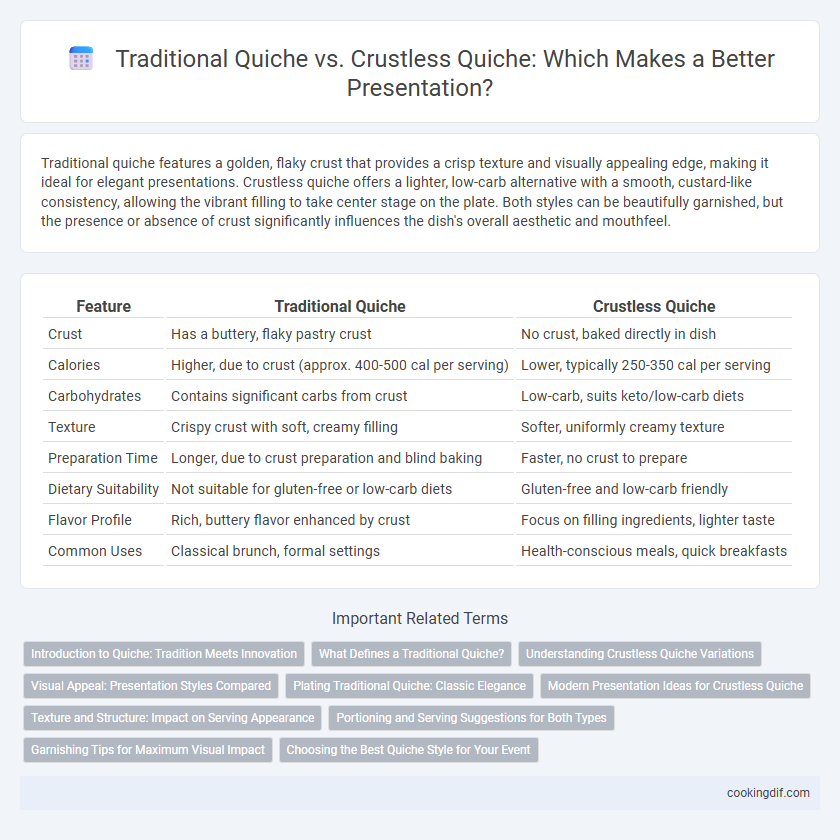Traditional quiche features a golden, flaky crust that provides a crisp texture and visually appealing edge, making it ideal for elegant presentations. Crustless quiche offers a lighter, low-carb alternative with a smooth, custard-like consistency, allowing the vibrant filling to take center stage on the plate. Both styles can be beautifully garnished, but the presence or absence of crust significantly influences the dish's overall aesthetic and mouthfeel.
Table of Comparison
| Feature | Traditional Quiche | Crustless Quiche |
|---|---|---|
| Crust | Has a buttery, flaky pastry crust | No crust, baked directly in dish |
| Calories | Higher, due to crust (approx. 400-500 cal per serving) | Lower, typically 250-350 cal per serving |
| Carbohydrates | Contains significant carbs from crust | Low-carb, suits keto/low-carb diets |
| Texture | Crispy crust with soft, creamy filling | Softer, uniformly creamy texture |
| Preparation Time | Longer, due to crust preparation and blind baking | Faster, no crust to prepare |
| Dietary Suitability | Not suitable for gluten-free or low-carb diets | Gluten-free and low-carb friendly |
| Flavor Profile | Rich, buttery flavor enhanced by crust | Focus on filling ingredients, lighter taste |
| Common Uses | Classical brunch, formal settings | Health-conscious meals, quick breakfasts |
Introduction to Quiche: Tradition Meets Innovation
Traditional quiche features a buttery, flaky crust that provides a rich, textured base contrasting with its creamy egg custard filling, often combined with ingredients like cheese, bacon, or vegetables. Crustless quiche eliminates the pastry shell, offering a lighter, gluten-free option that retains the savory custard essence while reducing calories and carbohydrates. Both variations showcase how classic French cuisine evolves, balancing hearty tradition with modern dietary preferences and presentation styles.
What Defines a Traditional Quiche?
Traditional quiche is defined by its buttery, flaky pastry crust that encases a rich custard made from eggs, cream, and often cheese, combined with ingredients like bacon, spinach, or mushrooms. The crust provides a structural base and a contrasting texture to the creamy filling, which is baked until set and golden on top. This classic form distinguishes traditional quiche from crustless versions, emphasizing both flavor depth and presentation.
Understanding Crustless Quiche Variations
Traditional quiche features a buttery, flaky crust that provides a firm base and contrast to the creamy egg filling, enhancing texture and flavor complexity. Crustless quiche variations eliminate the crust, resulting in a lighter, lower-carb option that emphasizes a custard-like consistency and rich fillings such as spinach, mushrooms, or cheese. Understanding these differences helps tailor presentations to dietary preferences, catering to gluten-free and calorie-conscious audiences without sacrificing savory taste.
Visual Appeal: Presentation Styles Compared
Traditional quiche features a golden, flaky crust that provides a classic, structured appearance, making it visually appealing on any serving platter. Crustless quiche offers a smooth, uniform surface that highlights vibrant fillings like spinach, tomatoes, and cheese, presenting a clean, modern aesthetic ideal for minimalist presentations. Both styles benefit from colorful garnishes and precise slicing, but the crust adds an extra layer of texture and visual depth that enhances traditional appeal.
Plating Traditional Quiche: Classic Elegance
Traditional quiche, with its golden, flaky crust, offers a visually appealing base that enhances plating elegance through structured slices and a defined shape. The crisp edges and uniform form create a sophisticated presentation ideal for formal dining or gourmet settings. Garnishing with fresh herbs or a light drizzle of sauce highlights the classic appeal, making each portion inviting and refined.
Modern Presentation Ideas for Crustless Quiche
Crustless quiche offers a sleek, low-carb alternative to traditional quiche, allowing for a refined and visually striking presentation ideal for modern culinary trends. Utilizing ramekins or silicone molds creates individual portions that emphasize vibrant fillings and fresh herbs, enhancing color contrast and texture appeal. Garnishing with microgreens, edible flowers, or a drizzle of flavored oil elevates the minimalist aesthetic, making crustless quiche perfect for elegant brunches or stylish dinner parties.
Texture and Structure: Impact on Serving Appearance
Traditional quiche features a flaky, golden pastry crust that provides a firm structure and a visually appealing base, enhancing the overall presentation with defined edges and contrast between crust and filling. Crustless quiche offers a softer, uniform texture without the crisp shell, resulting in a smoother, more custard-like appearance that can appear less structured but highlights the filling's ingredients more prominently. Choosing traditional quiche enhances slice stability and a classic look, while crustless quiche delivers a creamy, cohesive serving ideal for a refined or gluten-free presentation.
Portioning and Serving Suggestions for Both Types
Traditional quiche, with its firm crust, offers well-defined slices that hold shape perfectly, making it ideal for formal presentations and buffet-style serving. Crustless quiche, softer and more custard-like, requires careful portioning using a sharp knife or serving spatula to maintain neat portions, best suited for casual or individual plating. Both types benefit from garnishes like fresh herbs or a side salad to enhance visual appeal and complement flavors.
Garnishing Tips for Maximum Visual Impact
Traditional quiche with its golden, flaky crust provides a natural frame that enhances vibrant garnishes like fresh herbs, edible flowers, and colorful vegetable slices, creating striking visual layers. Crustless quiche offers a smooth, uniform surface ideal for precise, artistic toppings such as arranged cherry tomatoes, microgreens, or thinly sliced radishes that highlight texture contrast. Strategic placement of garnishes in both styles maximizes color contrast and depth, elevating the overall presentation for a gourmet appearance.
Choosing the Best Quiche Style for Your Event
Traditional quiche features a flaky, buttery crust that provides a satisfying texture contrast to the creamy, savory filling, making it ideal for formal events where presentation matters. Crustless quiche offers a lighter, gluten-free option that highlights the rich, custard-like interior and is perfect for health-conscious guests or casual gatherings. Selecting the best quiche style depends on balancing dietary preferences, event formality, and desired presentation impact.
Traditional quiche vs crustless quiche for presentation Infographic

 cookingdif.com
cookingdif.com